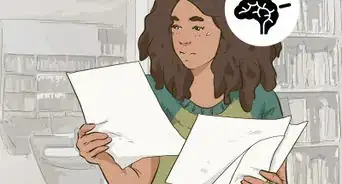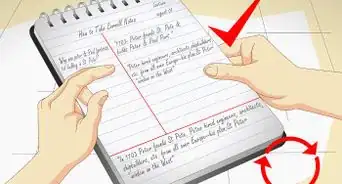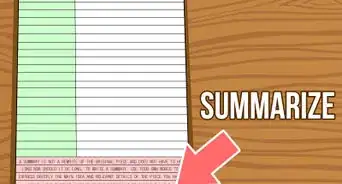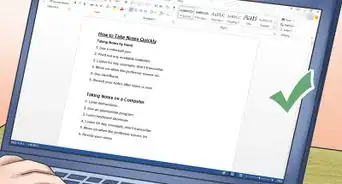This article was co-authored by Stephanie Wong Ken, MFA. Stephanie Wong Ken is a writer based in Canada. Stephanie's writing has appeared in Joyland, Catapult, Pithead Chapel, Cosmonaut's Avenue, and other publications. She holds an MFA in Fiction and Creative Writing from Portland State University.
wikiHow marks an article as reader-approved once it receives enough positive feedback. This article received 16 testimonials and 91% of readers who voted found it helpful, earning it our reader-approved status.
This article has been viewed 808,831 times.
Annotating a book is a great way to make notes on the text. It also allows you to do a deep read of the book, where you jot down your thoughts or impressions of the text. You may need to annotate a book for a class or decide to try it to deepen your reading experience. Start by selecting your annotation tool. Then, annotate the book by focusing on keywords, phrases, ideas, and questions so your notes are clear and easy to review later.
Steps
Selecting Your Annotation Tool
-
1Annotate with a highlighter and a pen or pencil. One of the easiest ways to annotate a book is to use a highlighter and pen or pencil directly on the text. Choose a highlighter in a shade that is easy for you to read on the page, such as a light blue or orange color. The standard yellow highlighter shade would also work too. Go for a pen in a dark color so it's easy to read.
- Try to stick to one highlighter color for the annotation so you do not end up with highlighted pages that are hard to re read.
- Choose the highlighter and pen or pencil option if it's okay for you to mark up the text.
-
2Use sticky notes or tabs if you can't mark up the book. Sticky notes or sticky tabs are a good option if you’d prefer not to mark up the book’s pages. Get colored sticky notes or tabs to mark pages or passages as part of your annotations.[1]
- Look for sticky notes and tabs in different colors. You can then use the different colored notes or tabs to annotate the book.
Advertisement -
3Try an electronic annotation program. If you are annotating a book on an eReader, there are several different annotation programs you can download. Programs like Skim and Marvin make it easy for you to annotate a text on your Reader.[2]
- You can download electronic annotation programs in the Apps store on your eReader.
Annotating Keywords, Phrases, and Sections
-
1Remove distractions. Go to a quiet, isolated spot at school, like the library or a study hall. If you are at home, close the door of your room and let others around you know you are not to be disturbed.
-
2Read the book slowly and carefully. To annotate a book properly, you need to take your time and read the book slowly. Pay attention to each word in the text. Pause and think about a passage in the text before moving on. Moving slowly through the text will ensure you do not miss anything and that you annotate the text well.[3]
-
3Underline key phrases. Start by underlining any phrases that feel important to you. Often, key phrases appear at the end of a sentence. They may also appear after a colon or a comma. Look for phrases that appear several times in the text, as they are likely important.[4]
- Try to only underline phrases that seem very important in the text. You do not want to end up with pages of underlined phrases, as it will be difficult for you to determine which ones are actually important.
- You can also underline phrases you like or find interesting. If a sentence strikes you or stands out to you, underline it so you can return to it later.
-
4Circle or box key words. Look for words that seem important to the author. You may circle words that connect back to the main idea in a section. Or you may draw a box around words that are repeated several times in the book.[5]
- For example, if you notice the word “power” appears several times in the text, circle or box it as an annotation.
- The author may tell you to keep certain words in mind as you read the text. Make sure you circle or box these words as part of your annotations.
-
5Bracket key sections. If you feel several lines in a section are important, use brackets to indicate this in the text. Try to choose only several lines or short sections of the text to bracket. Bracketing long sections can make it hard for you to return to the annotation later and get a clear sense of why you noted the section.[6]
- For example, if there is a section that focuses on a particular case study in the text you find interesting or important, use a bracket in the margins to annotate it.
-
6Make a list of words you don’t recognize. Keep a running list of words that you do not know or are not familiar with. Write them down on a separate piece of paper or at the end of the text. Then, look up the terms so you know what they mean. Consider the meaning of the term in the context of where it appears in the book.
- Keep a dictionary handy so you can look up terms you do not recognize quickly and easily.
Making Note of Key Ideas and Questions
-
1Reflect on the book in the margins. Have a conversation with the text by writing down your thoughts and reflections in the margins as you read. You may write one or two words to mark your thoughts. You can also jot down short phrases in the margins as they come.[7]
- As you read, ask yourself questions like, "What is the author trying to tell me as the reader?" "Why is this passage in the text?" "How do I respond emotionally to the text?"
-
2Make a list of questions you have about the book. As you read, write down any questions you have about the text. Jot them down in the margins or at the bottom of the page. Ask questions about words or phrases that confuse you. Pose questions about ideas that you find hard to follow or do not agree with.[8]
- For example, you may ask questions like, "Why did the author include this example in the book?" "What is the goal of the author in this passage?" "What is the author trying to say here?"
- To make the questions short so they can fit into the margins, you may simply put a question mark next to passages you do not understand. Or you may write the questions like, "Goal of the author?" "What is being said?" to keep them short.
- You can also keep the questions in a separate notebook or piece of paper so you do not clutter up the margins of the book.
-
3Link ideas together with arrows. Use arrows or lines to connect ideas and themes together in the text. You may circle key words on the same page and then link them together with arrows. Or you could highlight a passage and draw an arrow to another passage further down the page.[9]
- Linking ideas together will help you think critically about the text. It will also deepen your annotations and notes on the text.
-
4Summarize each section at the bottom of the page. Once you have completed a section of the book, try to condense the main thoughts and ideas in the section with a few key words. Write these key words at the bottom of the page so you can return to them later.[10]
- For example, you may summarize a passage in the book with key words like “power,” “female sexuality,” and “Freud case study.”
- You can keep your summaries in a separate notebook or piece of paper so the margins do not become cluttered with your notes.
Community Q&A
-
QuestionIf I'm doing this for school, should I buy a book or just get one from the library and use a notebook?
 Community AnswerI would say to buy the book so you don't have to bring both the book and a separate notebook to class every day.
Community AnswerI would say to buy the book so you don't have to bring both the book and a separate notebook to class every day. -
QuestionWhere do I put the Post-Its? Is there a certain place I'm supposed to place them?
 Community AnswerPut them at the top of the page upside-down so they hang out of the top. This allows you to quickly flip through them without having to open the book.
Community AnswerPut them at the top of the page upside-down so they hang out of the top. This allows you to quickly flip through them without having to open the book. -
QuestionIs there ever a wrong understanding of a book? I heard that every person has their own understanding of the meaning, it's never just one, is that true?
 Community AnswerYes, there can be a wrong interpretation, but that doesn't mean there's only ever one right answer. For example, if you read about a couple's fight, there might be several valid reasons for why they are fighting, but if you said the neighbor's dog was at fault, you'd probably be wrong.
Community AnswerYes, there can be a wrong interpretation, but that doesn't mean there's only ever one right answer. For example, if you read about a couple's fight, there might be several valid reasons for why they are fighting, but if you said the neighbor's dog was at fault, you'd probably be wrong.
References
- ↑ https://research.ewu.edu/writers_c_read_study_strategies
- ↑ https://learningcenter.unc.edu/tips-and-tools/annotating-texts/
- ↑ http://mas.dadeschools.net/pdf/Annotating%20a%20Text.pdf
- ↑ https://www.chino.k12.ca.us/site/handlers/filedownload.ashx?moduleinstanceid=34965&dataid=72719&FileName=Annotation%20Guidelines.pdf
- ↑ http://mas.dadeschools.net/pdf/Annotating%20a%20Text.pdf
- ↑ http://mas.dadeschools.net/pdf/Annotating%20a%20Text.pdf
- ↑ https://www.hunter.cuny.edu/rwc/handouts/the-writing-process-1/invention/Annotating-a-Text/
- ↑ https://learningcenter.unc.edu/tips-and-tools/annotating-texts/
- ↑ http://mas.dadeschools.net/pdf/Annotating%20a%20Text.pdf
About This Article
To annotate a book, grab a highlighter or pencil if you can mark the book, or a pad of sticky notes if you can't. Read the book slowly and carefully, underlining, highlighting, or noting interesting parts as you encounter them. Draw circles around key words and phrases, and include reflections, comments, and questions in the margins. If you're annotating a longer book, write short summaries on sticky notes at the end of each section to jog your memory. For tips on choosing what to mark and note, scroll down!











































































